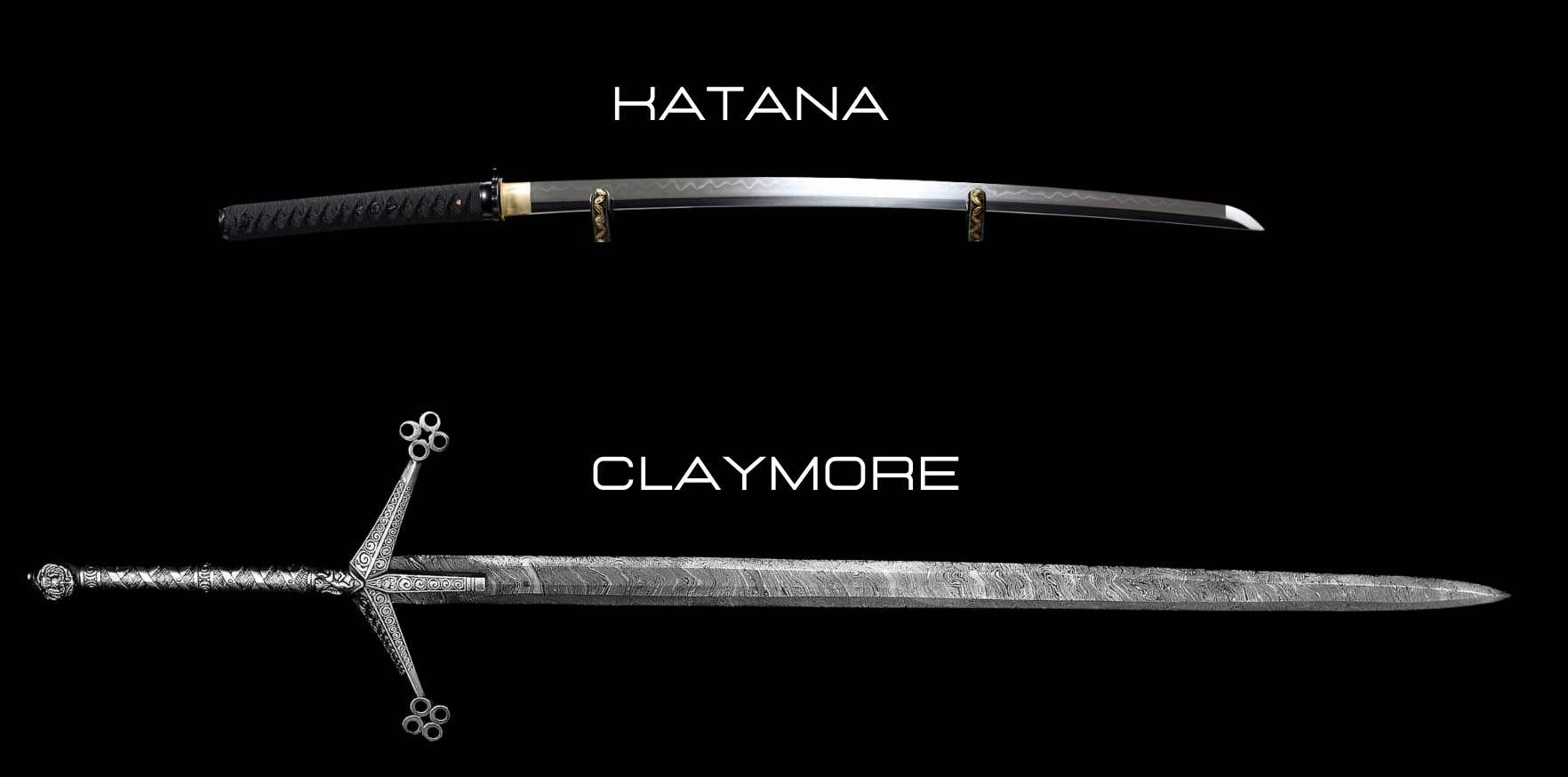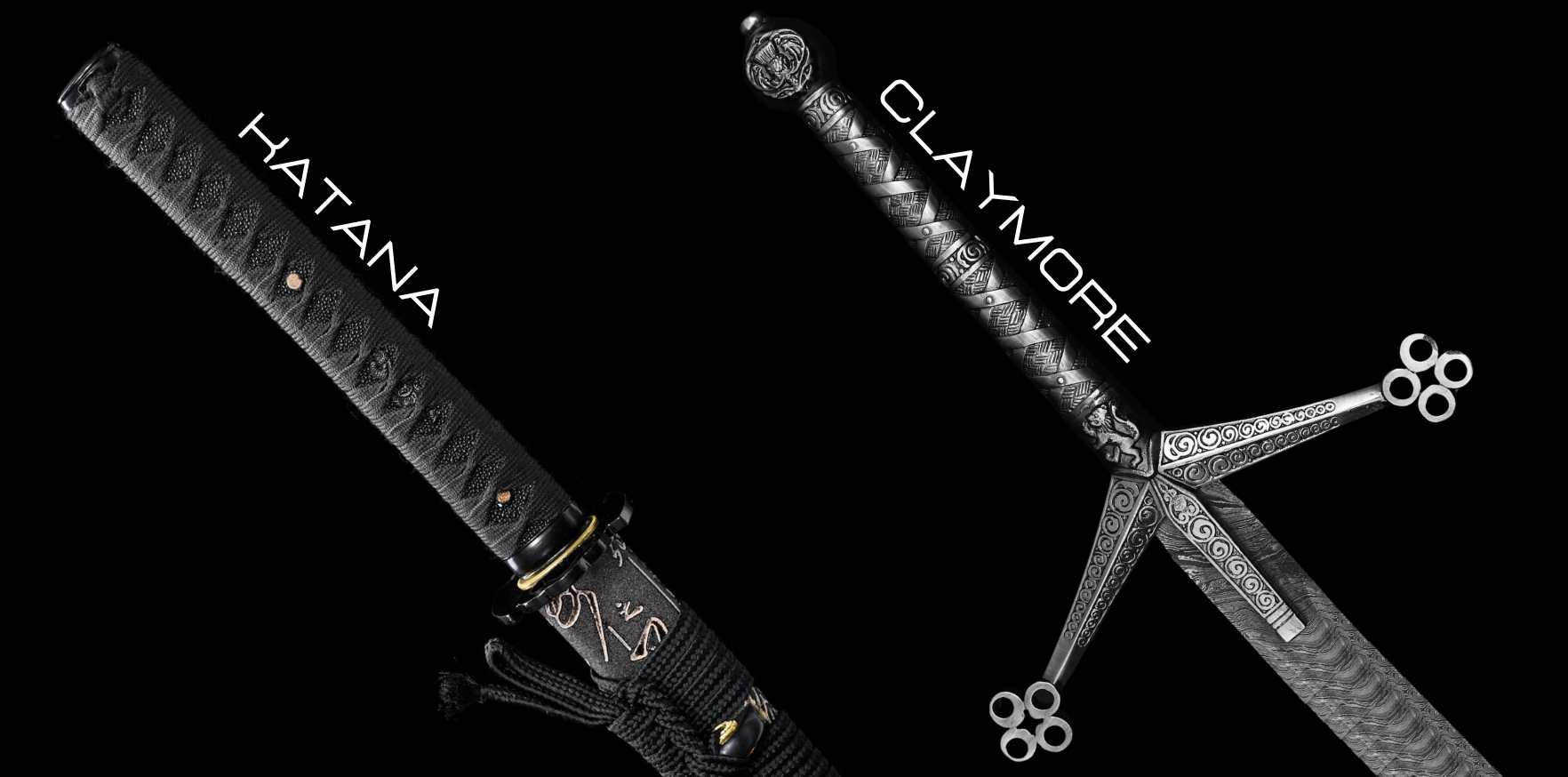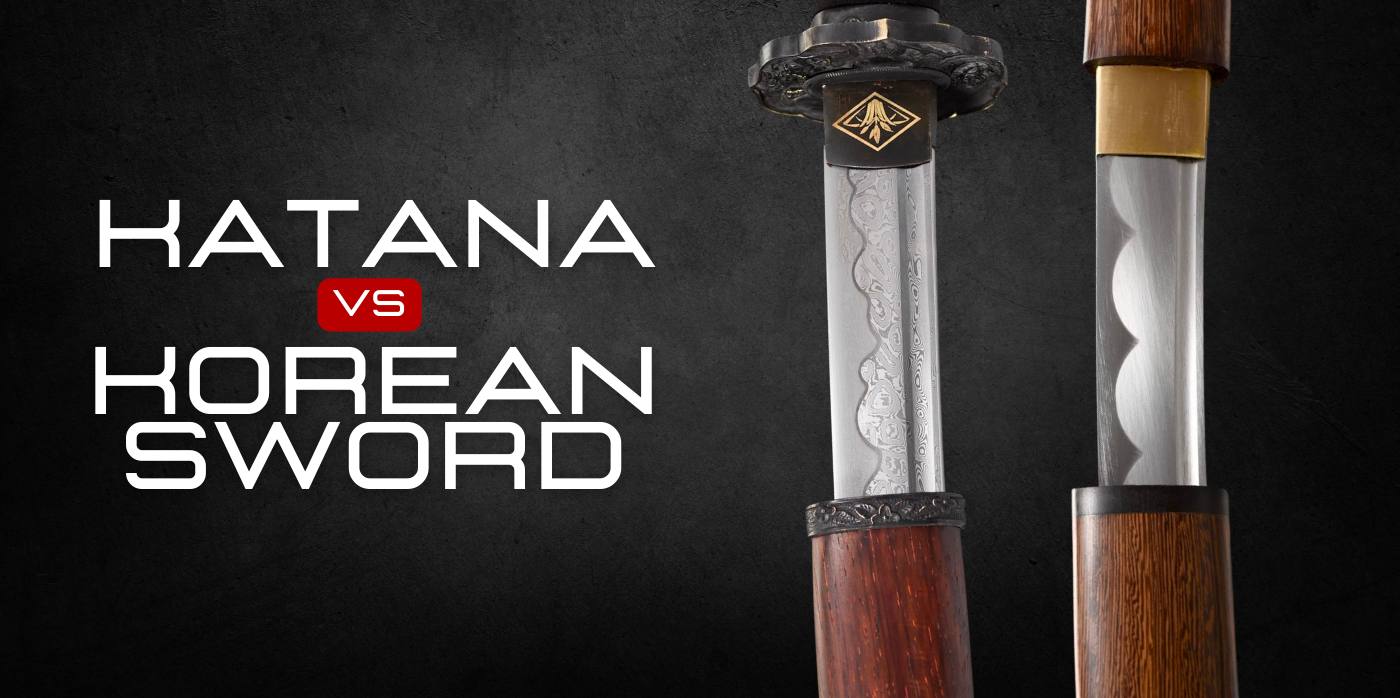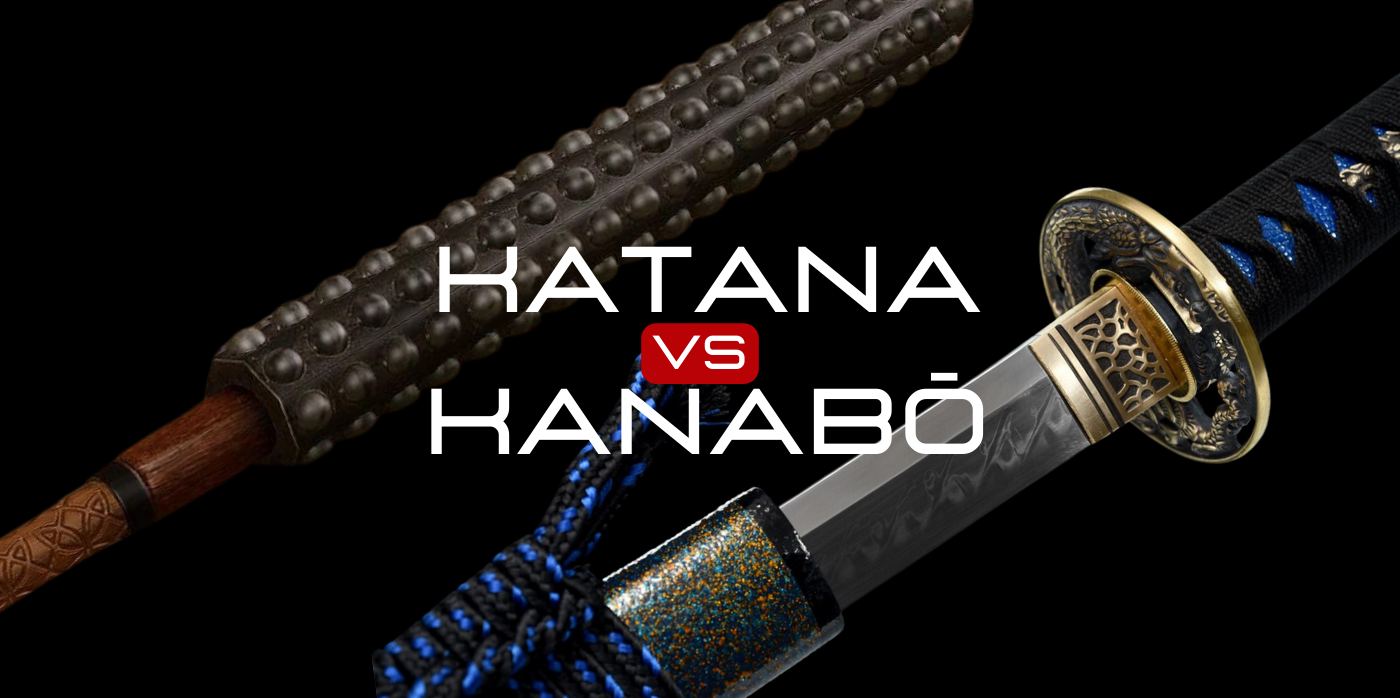Imagine you're at a historical weapons exhibit, peering through the glass at two of the most iconic swords from history: the katana and the claymore. These aren't just any old pieces of metal, mind you. Each tells the tale of the warriors who wielded them, the battles they fought, and the cultures they come from.
In this blog, we'll dive into a detailed comparison of the katana and the claymore—two swords that have carved their names into history. From the misty highlands of Scotland to the blossoming landscapes of Japan, these weapons embody the spirit and tradition of their times. We'll explore their origins, uses, and the very hands that forged and fought with them, making history with every swing.
Katana Sword VS Scottish Claymore
The katana and the claymore are both iconic swords, but they come from very different traditions and were designed for different uses.
| Feature | Katana | Claymore |
|---|---|---|
| Origin | Japan | Scotland |
| Use | Personal combat, dueling, ceremonial | Battlefield combat, breaking enemy lines |
| Average Length | 60-80 cm (blade length) | 120-140 cm (overall length) |
| Weight | 1.1-1.5 kg | 2-3 kg |
| Blade Type | Curved, single-edged | Straight, double-edged |
| Handle | Long, two-handed grip | Long, two-handed grip |
| Material | Tamahagane steel | Steel |

What is a Claymore Sword
The claymore is a type of traditional Scottish sword that has been historically used in the highlands of Scotland. The claymore is part of the longsword family, which we have already put to the test against the katana in our blog post about katana VS longsword.
There are two main types of swords referred to as "claymore" which are distinct in their design and era of use:
- Two-Handed Claymore: This is the older type of claymore, primarily used from the 15th to 17th centuries. It features a large, two-handed, double-edged blade. The blade length can be around 45 to 55 inches, making it quite substantial and heavy. The grip is designed to accommodate both hands for effective wielding. Notably, the claymore has a distinctive crossguard that is often characterized by its upward-sloping arms that sometimes end in quatrefoil designs. This sword was designed for swinging and cleaving through opponents, useful in the battles and melees of medieval Scotland.
- Basket-Hilted Claymore: Emerging in the late 16th century and becoming more common in the 17th and 18th centuries, this type of claymore is distinguished by its basket-shaped hilt that fully encloses the wielder's hand. This design provides significant protection against enemy blows. The blade of the basket-hilted claymore is usually single-edged, unlike the double-edged blade of the earlier version. It was a popular choice in the context of both military and dueling use during its time.
Claymore sword characteristics
The claymore sword, especially when referring to the traditional two-handed version from Scotland, has several distinct characteristics that set it apart from other medieval European swords. Here are the key features of the two-handed claymore:
- Size: The claymore is notably large, with a total length typically ranging from about 55 to 60 inches. The blade alone can measure around 45 inches.
- Blade: It has a straight, double-edged blade that is broad and often bears a deep fuller (the groove running along the blade) to reduce weight while maintaining strength. The edges taper smoothly to a sharp point, suited for both slashing and thrusting.
- Guard: The crossguard is a prominent feature, typically quite long and characterized by its forward-sloping arms. The ends of the guard may be quatrefoil-shaped, which are decorative yet also functional in trapping or deflecting an opponent’s blade.
- Grip: The grip is long, designed to accommodate two hands comfortably. This allows the wielder to exert greater control and force, essential for handling such a large sword.
- Pommel: The pommel at the end of the grip is large and often rounded, serving as a counterweight to balance the blade's considerable length and weight. This helps in making the sword more manageable and in delivering powerful blows.
- Construction: Traditionally, claymores were made from high-quality steel, forged to create a resilient blade capable of withstanding rigorous combat situations.

Katana Craftsmanship vs claymore
Katana Craftsmanship
- Material: The katana is famously made from a special type of steel called "tamahagane," produced from iron sand and charcoal in a traditional smelting process that results in a steel with varying carbon content. Tamahagane katanas are reputed for their sharpness and durability.
- Forging Process: The steel is carefully folded and forged multiple times to create layers that enhance the blade's strength and create the distinctive pattern known as "hada" or grain. This process also helps eliminate impurities.
- Differential Hardening: One of the most distinctive features of katana making is the differential hardening of the blade. The spine of the blade is covered with a layer of clay while the edge is left exposed, allowing the edge to be much harder than the spine, resulting in a blade that is extremely hard and capable of holding a razor-sharp edge, while the spine remains softer and more flexible, able to absorb shocks.
- Polishing and Sharpening: After forging, the katana is meticulously polished using a series of finer stones to enhance its cutting ability and aesthetic appeal. This also highlights the "hamon," or temper line, which is a visual effect created by the differential hardening process.
Claymore Craftsmanship
- Material: Claymores were typically made from steel, which was less specialized than the Japanese tamahagane but effective for large, two-handed weapons.
- Forging Process: The claymore blade was forged from a single piece of steel and often included a fuller (a groove running along the blade) to reduce weight without sacrificing strength. This made the large sword easier to handle.
- Design: The focus in claymore design was on creating a large, effective two-handed weapon. The crossguard was typically quite elaborate, with forward-sloping arms and quatrefoil ends that could serve both aesthetic and functional purposes, such as catching an opponent's blade.
- Balance and Functionality: The large pommel of the claymore served as a counterbalance to the long blade, which was essential for maintaining control of the sword during swinging motions. This balance was crucial for a weapon designed primarily for powerful cleaving strikes in battle.

Katana combat style vs claymore
COMPARATIVE OVERVIEW:
- Katana: Emphasizes precision, speed, and technique, reflecting the individualized and disciplined approach to combat typical of the samurai. The focus is on effective, often lethal strikes with minimal effort and movement.
- Claymore: Focuses on strength, reach, and the ability to engage multiple foes, suitable for the chaotic melee of medieval Scottish warfare. The style reflects a need for impactful, sweeping moves that can turn the tide in group combat.
The katana and claymore are both iconic swords, but they are designed for vastly different combat styles that reflect their respective cultural and historical contexts. Here's how the combat styles differ for each sword:
Katana Combat Style
- Technique and Agility: The katana is characterized by its agility and precision in cutting. Samurai were trained in various techniques to deliver quick, clean cuts with a single stroke, often targeting specific points on an opponent's body. The curvature of the katana facilitates slicing motions, making it exceptionally effective for swift, precise strikes.
- Stance and Movement: Samurai utilized various stances and techniques that emphasized balance, control, and efficiency. Techniques such as "Iaido" focus on the smooth, controlled movements of drawing the sword and striking in a single motion. This reflects a philosophy of not only combat efficiency but also the spiritual and disciplined nature of the samurai.
- Dual Use: The katana was part of a larger weapon system that often included the "wakizashi" or a shorter sword, which could be used for close combat or ceremonial purposes. This combination allowed for versatility in various combat scenarios.
Claymore Combat Style
- Power and Reach: The claymore, with its large, double-edged blade and long grip, is designed for power and reach, allowing the wielder to perform large sweeping or chopping motions. It was often used to break through the ranks of enemy troops or combat multiple opponents.
- Two-Handed Technique: Given its size, the claymore was primarily wielded with two hands, providing the necessary leverage to control its heavy blade during combat. This style is conducive to powerful strikes rather than quick, precise cuts.
- Battlefield Utility: The claymore was a battlefield weapon, designed to be used in open combat. Its size and design made it less practical for dueling or tight quarters than smaller, more maneuverable weapons. The large crossguard was also useful in deflecting incoming strikes from opponents’ weapons.





